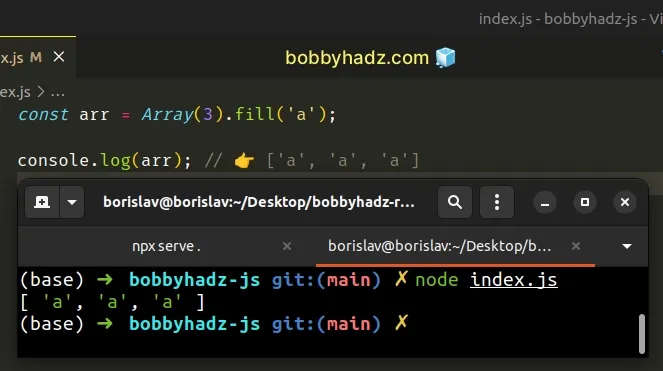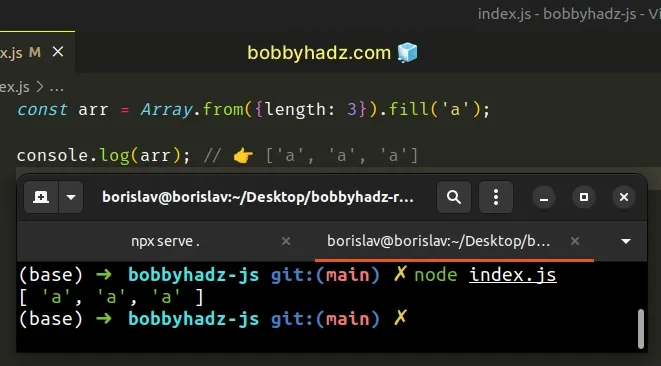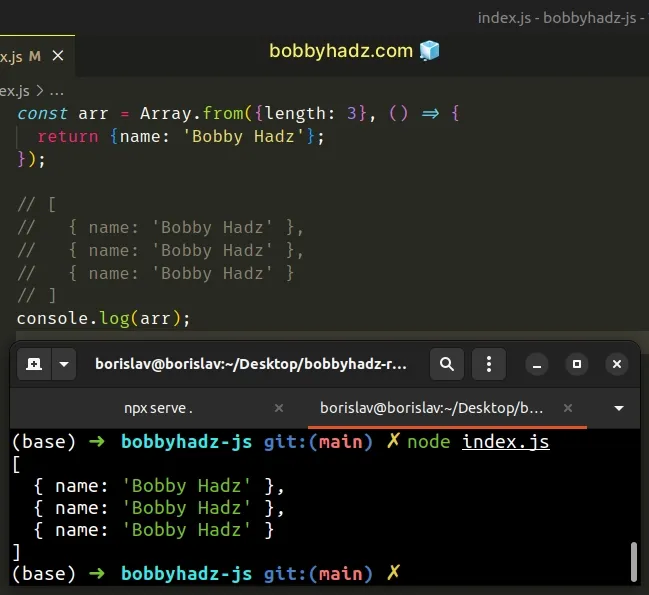Create an Array with N elements, same Value in JavaScript
Last updated: Mar 1, 2024
Reading time·4 min

# Create an Array with N elements, same Value in JavaScript
To create an array with N elements containing the same value:
- Use the
Array()constructor to create an array of N elements. - Use the
fill()method to fill the array with a specific value. - The
fill()method changes all elements in the array to the supplied value.
const arr = Array(3).fill('a'); console.log(arr); // 👉️ ['a', 'a', 'a']

Array() constructor, to create an array containing 3 empty elements.// 👇️ [ <3 empty items> ] console.log(Array(3));
We used the Array.fill() method to fill the array with a specific value.
// 👇️ [ 'abc', 'abc', 'abc' ] console.log(Array(3).fill('abc'));
The method takes a value and uses it to replace all array elements.
# Using the Array.from() method instead
Alternatively, you can use the Array.from() method instead of the Array()
constructor.
const arr = Array.from({length: 3}).fill('a'); console.log(arr); // 👉️ ['a', 'a', 'a']

We passed the desired array length as an argument to the Array.from() method.
Array.from method is a little more explicit and easier to read than instantiating the Array constructor.# Create an Array of N non-primitive elements with the same value
When creating an array of N non-primitive elements with the same value, use the
Array.from() method.
const arr = Array.from({length: 3}, () => { return {name: 'Bobby Hadz'}; }); // [ // { name: 'Bobby Hadz' }, // { name: 'Bobby Hadz' }, // { name: 'Bobby Hadz' } // ] console.log(arr);

Creating an array of non-primitive values is a bit trickier because we have to ensure that the objects in the array don't have the same reference.
If the objects are stored at the same location in memory, once one object gets updated, they all get updated.
Instead, we passed a map() function as the second argument to the
Array.from() method.
On each call of the map function, we return an object.
If you update one object, the changes won't be reflected in the object objects because they are all stored in different locations in memory.
const arr = Array.from({length: 3}, () => { return {name: 'Bobby Hadz'}; }); // [ // { name: 'Bobby Hadz' }, // { name: 'Bobby Hadz' }, // { name: 'Bobby Hadz' } // ] console.log(arr); arr[0].name = 'new'; // [ { name: 'new' }, { name: 'Bobby Hadz' }, { name: 'Bobby Hadz' } ] console.log(arr);
Updating the name property of the first object didn't update the property in
the other objects.
# Creating a two-dimensional array with N elements, same value
The same approach can be used to create a two-dimensional array with N elements, same value.
const arr = Array.from({length: 2}, () => Array.from({length: 3}, () => { return {name: 'Bobby Hadz'}; }), ); // [ // [ // { name: 'Bobby Hadz' }, // { name: 'Bobby Hadz' }, // { name: 'Bobby Hadz' } // ], // [ // { name: 'Bobby Hadz' }, // { name: 'Bobby Hadz' }, // { name: 'Bobby Hadz' } // ] // ] console.log(arr);
Notice that we used the Array.from() method twice.
The outer call to the Array.from() method determines the length of the outer
array.
The nested call to Array.from() determines the length of each nested array.
# Repeating multiple values N times
You can use the same approach if you need to create an array by repeating multiple values N times.
const arr = Array(3).fill(['a', 'b', 'c']).flat(); // [ // 'a', 'b', 'c', // 'a', 'b', 'c', // 'a', 'b', 'c' // ] console.log(arr);
We passed an array of values to the Array.fill() method and then used the
Array.flat() method to flatten the array.
You can also pass a map function as the second argument to the Array.from()
method when working with primitives.
const arr = Array.from({length: 5}, () => { return 'a'; }); // 👇️ [ 'a', 'a', 'a', 'a', 'a' ] console.log(arr);
The code sample creates an array of 5 elements with the value of a.
You can also explicitly chain a call to the Array.map() function on the output
of the Array.from() method.
const arr = Array.from(Array(5)).map(() => { return 'a'; }); // 👇️ [ 'a', 'a', 'a', 'a', 'a' ] console.log(arr);
The Array.map() function gets called for each element in the array.
Alternatively, you can use a for loop.
# Create an Array with N elements, same Value using a for loop
This is a three-step process:
- Declare a variable that stores an empty array.
- Use a
forloop to iterate N times. - On each iteration, push the value into the array.
const arr = []; const total = 3; for (let i = 0; i < total; i++) { arr.push('a'); } console.log(arr); // 👉️ ['a', 'a', 'a']
We declared a new arr variable and initialized it to an empty array.
We used a for loop to iterate N times and on each iteration, we pushed the
value into the new array.
Using a for loop is a bit more verbose, but many developers are familiar with
how loops work.
# Create an Array with N elements, same Value using a while loop
You can also use a while loop to create an array of N elements with the same
value.
let total = 3; const arr = []; while (total--) { arr.push('a'); } console.log(arr); // 👉️ [ 'a', 'a', 'a' ]
On each iteration of the while loop, we decrement the total variable until
it gets set to 0.
Zero is a falsy value in JavaScript, so once 0 is reached, the loop exits.
# Additional Resources
You can learn more about the related topics by checking out the following tutorials:

